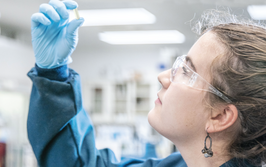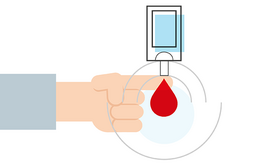Through the Looking Glass
There is a shocking lack of attention given to racemization in drug discovery, despite it having huge implications on the efficacy – and safety – of drugs. We hope the tool we have developed will be the first step towards change.
Many drugs are chiral molecules: they have the potential to “flip” and exist as different enantiomers – non-superimposable mirror images of the original molecule with an identical chemical structure. In some cases, this flipping behavior can occur when an enantiomerically pure drug enters the body, in a process known as racemization. Typically, only one of the two enantiomers is useful, meaning that the pharmaceutical action of a significant fraction of all drugs depends on administering the correct enantiomer. The reason why typically only one enantiomer is useful is that biological targets of drugs are usually just one mirror image. Therefore, when we administer a mixture of enantiomers, one will act as intended but the other enantiomer could be a bad fit with the target, leading to this unwanted enantiomer binding to unintended targets, potentially causing serious side effects.
The tragic story of thalidomide is often cited as a reason for the need for enantioselective synthesis in academia, and triggered the current approach to enantiomers in the pharmaceutical industry. Thalidomide, which was discovered by the German company Chemie Grünenthal, was given to women as a mixture of the two mirror images to treat morning sickness in pregnancy. It is often said that the desired enantiomer acts as required, but the second enantiomer is teratogenic and therefore led to severe birth defects. As a result of the thalidomide tragedy, new drugs can no longer be mixtures of two enantiomers – so called racemic mixtures – unless the effects of both enantiomers have been studied fully.
Today, almost everyone is aware of the need to administer single enantiomer drugs – and enormous amounts of time and money are invested in the development of synthetic routes to make single enantiomers. In fact, syntheses producing racemic mixtures have become all but unpublishable.
But even if single enantiomers are synthesized there is a risk for the pharmaceutical industry; if the enantiomer racemizes and racemization is discovered late in the drug discovery process, the compound becomes a dead end, wasting precious time and money. And it’s not only in drug design where racemization is a risk; in the identification of new natural compounds, one also needs to be aware of the risk that stereogenic centers may have racemized. Similarly, probe molecules are used a lot in biological chemistry, system biology, and so on – and these, too, can racemize.
Despite how crucial racemization is in a number of fields, there have been no good models to quantitatively predict how these enantiomers will behave once exposed to aqueous conditions in the body. The absence of good workable tools appears to have generated an attitude where the risk was readily swept under the proverbial carpet. In fairness, studying racemization isn’t simple; it requires the right equipment as well as dedicated fundamental studies of the kinetics and mechanisms of racemization reactions. My attention was drawn to this blind spot through conversations with a friend who worked at AstraZeneca. When we started to look for data to start to predict racemization risk, we discovered there was almost none available in the literature, which came as a real shock! We therefore set out to generate the data we needed. To develop a predictive model, we needed a significant experimental dataset, which three PhD students acquired over roughly ten years. We also needed the right project team. Our predictive model required a correlation between results from kinetic studies in my group in Cardiff with data from computational work in the Leach group at Liverpool John Moores University; without either set of data, there is no correlation. Without correlation, there is no prediction. Finding funding for these kinds of fundamental studies is not always easy – but fortunately our sponsors, including AstraZeneca, recognized the importance of this work.
We have already received enquiries to study molecules potentially at risk and we are looking into these compounds now. We’re also developing a version of the model that predicts the risk of racemization during typical reaction workup procedures, and whether enantiomeric excess may have been lost during purification.
In my view, our guidelines and models provide an excellent approach to predicting racemization (1). We would like to see our quantitative predictions and experimental tests – what we consider much-needed tools – incorporated as standard in the drug discovery pipeline. Our hope is that the availability of these tools should lead to researchers being less inclined to sweep racemization risk under the carpet, helping to avoid dead ends, and design out racemization risk at an early stage of the drug discovery process.
- A Ballard et al., “Quantitative prediction of rate constants for aqueous racemization to avoid pointless stereoselective syntheses”, Angew Chem Int Ed, 57, 982 (2018).
Niek Buurma is Lecturer in Physical Organic Chemistry, School of Chemistry, University of Cardiff, UK.


















